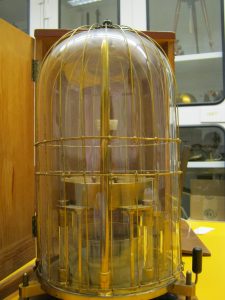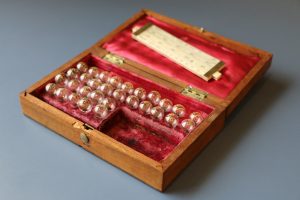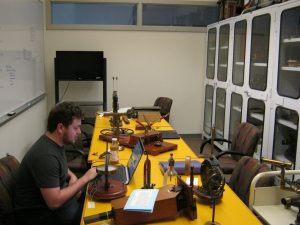Written by Mike Lally ’18
While organizing and cataloging the Science Antiques Collection Wendy and I came across a wooden box, standing about a 18 inches high and 10 inches deep.

Elliot’s Quadrant Electrometer
This is a Quadrant Electrometer, made by Elliott Bros. of London in the 1880s. It is a form of an electroscope, which allows more absolute measures of electrostatic potentials. This measures the presence and magnitude of a charge. When a device is attached to the contacts at the base of the machine, the needle floating inside points to the magnitude of the potential.
This machine would have been used within a classroom setting, with students learning about electrostatics. Additionally, the aesthetic qualities of this object indicate that along with its practical use, an artistic use emerges as well. One can imagine such a machine sitting in the parlor room in the late nineteenth century, guests staring at the item while its proud owner explains the machines use and provenance, yet admiring the beauty of object.
This and more aesthetically pleasing scientific instruments can be found in the 5th floor display in Bicentennial Hall.
 lined box are 31 hand blown glass beads with number painted on in gold paint, and a bone slide rule. Engraved on a small ivory plaque on the lid of the box are the words “Lovi Edinr Patentee.” After Wendy informed me that Edinr stands for Edinburgh, I quickly googled to find that they are aerometrical, or specific gravity, beads. Beads such as these, also known as “philosophical beads”, were invented by Alexander Wilson of Glasgow in the 1750s, and were used to determine the specific gravity of a fluid. The user would drop the beads into a liquid until finding the one with neutral buoyancy, which would indicate the specific gravity. By using the slide rule, one could then, for example, find the alcohol content in wine.
lined box are 31 hand blown glass beads with number painted on in gold paint, and a bone slide rule. Engraved on a small ivory plaque on the lid of the box are the words “Lovi Edinr Patentee.” After Wendy informed me that Edinr stands for Edinburgh, I quickly googled to find that they are aerometrical, or specific gravity, beads. Beads such as these, also known as “philosophical beads”, were invented by Alexander Wilson of Glasgow in the 1750s, and were used to determine the specific gravity of a fluid. The user would drop the beads into a liquid until finding the one with neutral buoyancy, which would indicate the specific gravity. By using the slide rule, one could then, for example, find the alcohol content in wine.
You must be logged in to post a comment.